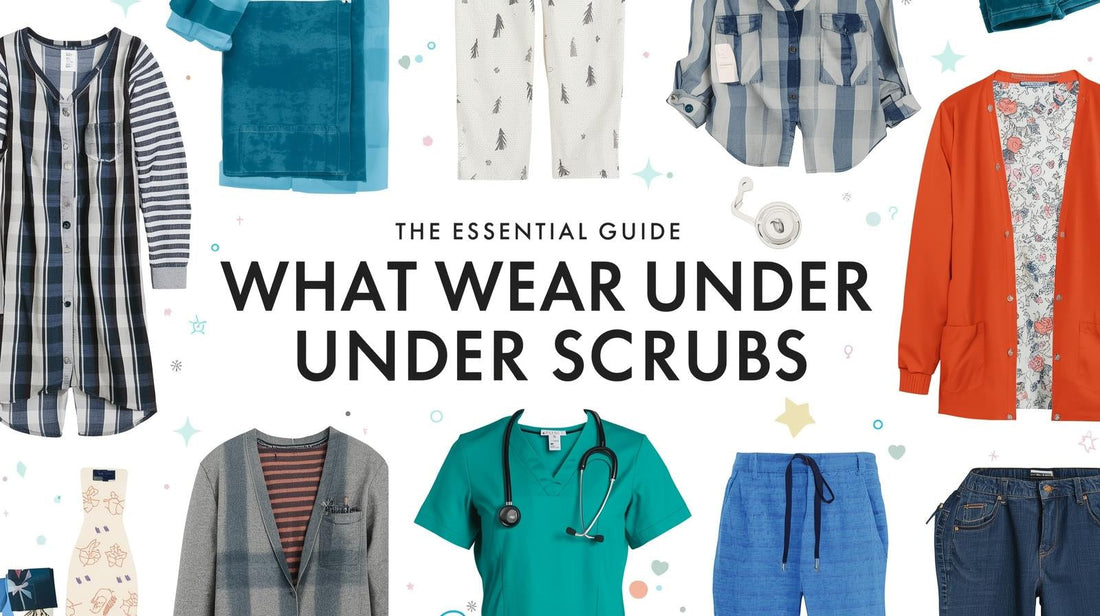Scrubs get all the attention when healthcare workers shop for uniforms. What goes underneath? That's an afterthought until chafing strikes three hours into a shift. The right undergarments can change everything about a 12-hour workday. Skin stays protected, appearance stays professional, and body temperature stays manageable instead of swinging between freezing and overheated.
Starting With Base Layers
Fabric makes or breaks comfort during long shifts. Moisture-wicking materials pull sweat off skin instead of trapping it. Cotton seems like the safe choice, but it holds moisture. A few hours in, that becomes uncomfortable fast.
What to Wear Under Scrubs comes down to what works for each person. Compression shorts or fitted boxer briefs solve the thigh chafing problem that hits almost everyone eventually. Men and women both rely on these now. Seamless versions get rid of panty lines too, keeping everything smooth under scrubs.
Picking Underwear That Lasts
Choosing the right underwear can make a big difference in how comfortable you feel throughout the day. In medical settings, fabrics like bamboo, modal, or moisture-wicking materials work better than regular cotton because they dry faster and help prevent bacteria from building up, which is especially important when breaks are limited.
It’s best to avoid lace, decorations, or tight elastic that can leave marks or feel restrictive. High-waisted styles give better coverage when bending or reaching for supplies. For those working in colder areas, thermal underwear is a good option. Just make sure it’s breathable so you stay warm without feeling overheated during long, busy shifts.
Undershirts Make a Difference
A tank top or fitted undershirt under scrub tops does more than add a layer. It soaks up sweat and provides coverage. V-neck styles pair well with Men's Scrub Top designs because they stay out of sight while doing their job.
Compression shirts have caught on in hospitals and clinics. They give muscles support when lifting patients or moving equipment. They also help in those freezing operating rooms where someone always sets the AC too cold. Stick with white, nude, or colors that match skin tone so nothing shows through lighter scrubs.
Handling Temperature Problems
Hospitals have unpredictable temperature zones. Operating rooms run cold, while some patient areas get warm. Layering becomes important, starting with what sits against skin. Thin thermal base layers handle cold environments without adding bulk under scrubs.
Undershirts with mesh panels work better in warmer departments. Some newer fabrics actually adapt to body temperature changes. Anyone wanting to understand how fabrics work together can check the Guide to Medical Scrub Fabric for more details.
Sports Bras That Actually Work
Long shifts involve constant lifting, bending, and movement. Sports bras designed for medium to high-impact activities provide necessary support without uncomfortable underwires. Wider straps help distribute weight and prevent shoulder discomfort.
Racerback styles stay in place and don't peek out from scrub necklines. Moisture-wicking sports bras stop sweat from building up, which reduces skin irritation. Bralettes or light compression options suit people who want coverage without too much structure.
Socks Get Overlooked
Most people ignore socks until their feet hurt so bad they can barely walk. Compression socks help blood flow during long periods of standing. They cut down on leg tiredness and swelling. Getting the right fit matters because socks that are too tight restrict blood flow, while loose ones offer little benefit.
Cushioned athletic socks protect feet from hard hospital floors during all that walking. Moisture-wicking keeps feet dry and stops blisters before they start. Seamless toes mean one less thing rubbing and causing problems. Decent socks plus well-fitting Men's scrub pants makes shifts way more bearable.
Looking Professional Matters
What's underneath changes how scrubs look from the outside. Panty lines showing, fabric bunching up, or underwear visible through material ruins an otherwise put-together look. Nude or skin-tone pieces vanish under light scrubs. Black hides better under dark colors.
Thongs or seamless boy shorts eliminate lines without feeling uncomfortable. Colors matter here too, same way The Role of Color in Medical Scrubs matters for the overall look. Getting these choices right keeps everything neat.
Ready to upgrade scrub wardrobe essentials? Explore premium scrub options at Easure Scrubs, where quality meets comfort for healthcare professionals who demand the best.
Night Shifts Versus Day Shifts
Different shifts need different gear. Night people usually want warmer layers, since buildings cool down after hours. Day shift tends to be busier and more active, so breathability wins.
Anyone rotating between shifts needs options that work in different temperatures. Stashing backup undergarments in a locker means being able to change when necessary. That kind of preparation stops discomfort from messing with focus when things get hectic.
When to Toss and Replace
Nothing lasts forever. Elastic stretches out. Fabric thins. Moisture-wicking quits working. Swapping base layers every six to twelve months keeps things functional. Stuff that gets worn more often needs replacing sooner.
Washing things right helps them last. Use cool water. Don't use fabric softener, as it coats the fibers and kills their ability to wick moisture. Air dry when there's time. Keeping medical clothes separate from regular laundry stops cross-contamination and keeps hygiene where it should be.
Frequently Asked Questions
1. Should scrub pants be worn with leggings underneath?
Leggings help in cold places, but keep them thin and moisture-wicking so they don't cause overheating when things get busy.
2. What's the best material for undergarments beneath scrubs?
Moisture-wicking synthetics like polyester blends or natural stuff like bamboo and modal beat cotton at keeping skin dry.
3. Are compression garments necessary under scrubs?
Not required, but compression shorts help prevent chafing and compression socks boost circulation, making them useful additions for comfort during long work hours.
4. How many sets of undergarments should healthcare workers own?
Five to seven sets makes rotation easy without having to rewear damp or dirty items between washes.
5. Can regular underwear work under scrubs?
Regular underwear works fine if it's comfortable and doesn't show lines, but performance fabrics usually handle demanding shifts better.
